An important part of the latest Acimaf convention at Fontanellato, in the astonishing venue of Labirinto della Masone close to Parma, was dedicated to the analysis of the different conditions in which operate Italian and German manufacturing industries and machine producers, highlighting the resilience of the made in Italy, able to score record results.
Roberto Carminati
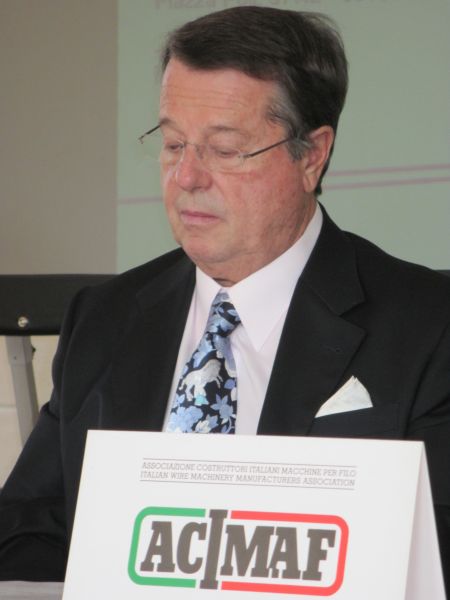
Ferruccio Bellina, number one of Acimaf and president of Tkt Group, focused his opening speech of the recent Acimaf convention on the key theme of clearness.
The similarities and the differences between doing business in Italy and in Germany and, consequently, contact points and distances of systemic type between the respective Country-Systems were the focus of the debate during the last Acimaf convention, the Association joined by tricolour wire machinery manufacturers. While it was essentially inspired by our contradictory relationships not only with our neighbours but also with Europe in general the opening speech by the Association president Ferruccio Bellina, who highlighted the key issue of clearness. It should be an absolute prerequisite to allow the industries of the Union member States to compete on equal terms in the free market. Nevertheless, how the number one of Acimaf and Tkt Group President in person underlined, we can notice relevant unbalances already in the preparatory phases of any commercial negotiation. Because where French or German entrepreneurs gain access easily to critical information about the balance sheets of Italian counterparts, the same does not happen when Italian players ask for analogue data. Beyond our borders and until not many years ago, only the accounts of listed companies had to be publicly issued mandatorily. When, instead the duty of releasing them was extended to companies of all sizes and typologies, immediately they found also a ploy to overcome the problem. A bit Italian-style, we could say with bitter irony: imposing in other words the payment of a sanction, neither too stiff (from 1,000 to 1,500 euro) to those who neglect to publish the documents concerning the trend of their activity. A discrepancy in behaviours and in the regulation that represents only one of the several criticalities that Italian managers have to face almost every day. In whose bedlam, however, they seem to be able to manage skilfully, considering the exploits of which they are able, as we will have the opportunity to observe. At Fontanellato, in the outskirts of Parma, in the extraordinary venue of Labirinto della Masone, strongly wished and created by the visionary designer and entrepreneur of graphic arts Franco Maria Ricci, that was essentially the subject. Our geniality and talent, the capability of reacting and winning.
Possible mission

Alessandro Di Biasio from The European House – Ambrosetti underlined that the bent for export of wire machinery manufacturers must be supported by institutional actions able to boost it, considering the typical « very intense competition dynamics» of globalization.
Overcoming the crisis seems now a target within the reach of our Country’s economy and the Peninsula in itself: however, it is difficult to say whether the major merits for the success of what seemed an impossible mission until just few years ago should be ascribed to institutions or others. Beyond the Alps, for instance, someone believes that the result is mainly the fruit of tricolour entrepreneurs’ good work instead of the teams followed one another at the Government with their attempts of reforming and boosting the economy, often miscarried. This is the opinion of some foreign managers got in touch, in recent and critical times, with The European House – Ambrosetti. Attending the recent convention of Acimaf with the partner Alessandro Di Biasio, the think tank involved the audience in an analysis of the different conditions in which we do business in Italy and in Germany. Relying also on data from heterogeneous sources, with the Position paper on The role of the Country-System in competitiveness the house stressed the strong and weak points of our economic fabric. At the opening of the proceedings, they duly underlined the performances of special machines, to which ambit precisely belong wire technologies, part of that wider machinery and engineering galaxy where some real national excellent realities keep on gravitating. According to what stated, in Italy the panorama of wire machines is subdivided into the so-called prime mover manufacturers, i.e. the anticipators of trends that will afterwards characterize the industry and the market, and into followers, slower but not less effective in keeping pace with innovation. The latter perhaps embody in the best and most complete manner the tradition of our nations’ entrepreneurship, they are in fact deemed able «to master the technological advances» in course. Moreover, even if with a certain delay compared to prime mover pioneers and visionaries, able «to integrate them into their offer system». Both business categories share some important characteristic traits. First «the capability of optimizing the management of the heritage of specialized knowledge and technologies» to create customized solutions able to satisfy customers’ concrete needs. Then, the service excellence that is decisive in the control of the most appealing target markets and the sharing of the innovative elements generated. In general, they can rely on a good and solid profitability, to the extent of supporting easily the critical investments in research and development areas; besides, on an international presence as well that compensates with the approach to rising nations the deficits currently affecting the demand from Europe and the most industrialized West Countries.
Structured and internationalized
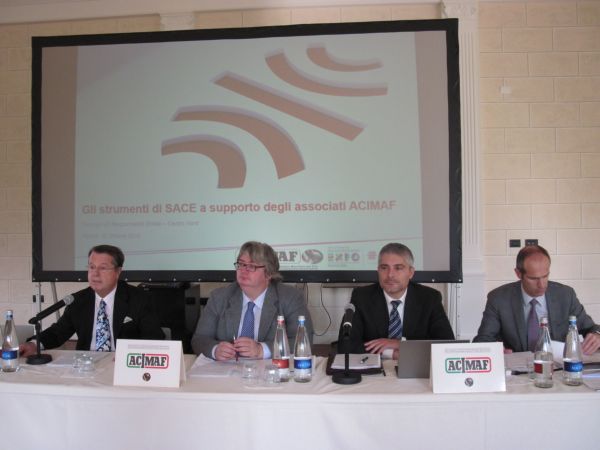
The table of speakers at the recent Acimaf convention.
The latter point involves a double interpretation. On one hand, in fact, the bent for export of wire machine manufacturers grants the possibility of finding, today and in the future, outlets in ambits with higher investment potentialities and stronger demands. On the other hand, however, this propensity must, or should, be supported by institutional measures able to enhance it, due to the typical «very intense competition dynamics» of globalization. The European House – Ambrosetti decisively highlighted this aspect, too, as we are going to see, however anticipating that the structural characteristics of drawing mills’ suppliers differ from those of a broad slice of the Italian manufacturing industry. On average, in fact, in the field operate smaller-size enterprises compared to German ones, the most direct competitors in the world. Moreover, statistics indicate that precisely the realities with a number of employees included between 50 and 249 generate 32.5% of the added value of the entire sector. A unique situation, since in Italy 82% of the production goes to companies with less than 10 employees versus 59% calculated in Germany. Their contribution in profit margins is by 11.7% compared to the German 3.4%. Deemed «a driving engine for industry», big enterprises having a labour force that exceeds 250 workers are in the laender almost the quadruple than by us: 4,109 against 1,269. And they achieve 65% of the added value, here stopped at 34%. Finally, industrial giants in Germany employ 52% of workers, in the Peninsula 23%. The real Italian wonder is done by the mechanical manufacturing industry that, despite the more modest dimension of its players and the differences of the economic account, not only skilfully gets by but also it even manages to grow. As reported by ONU numbers that still in 2012 placed it among the six leaders on a global scale by added value. Moreover, it is confirmed by the «excellent export performances that, coupled with the import decrease, in 2014 rose the trade balance to the highest historical values: 43 billion Euros, 86 net of energy products». Furthermore, «textile, pharmaceutical and food-processing machinery» were the drivers of the sale boom beyond the EU borders (+4.1%) while the machinery and equipment area conquered the 9.7% market share in the tricolour business bouquet, with an added value worth a good 30 billions. Essential are then the activation coefficient, corresponding to 2.78 points, that characterizes the domestic machinery, witnessing the capability of transmitting transversal benefits to the economic system; in addition, the fact that our export is generally oriented towards nations with high per capita GDP.
Competitive, despite all
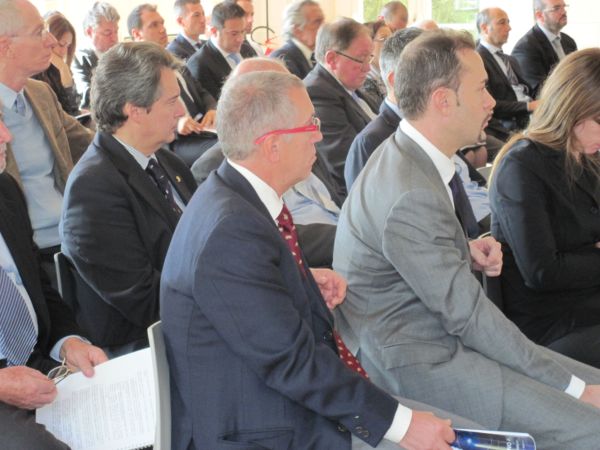
Acimaf convention aroused the lively interest of a wide audience of players.
All, or almost all, the numbers above seen seem to share in consolidating the thesis by the anonymous manager described by Di Biasio at Acimaf forum, that is to say that enterprises, much more than politics, have backed the Italian economy, preventing it from crumbling dramatically. Because, when we analyse, as it happens in the Position paper by The European House – Ambrosetti, the overall survey, we can notice that Italy ranks last but two in Europe by «system competitiveness». According to estimates dating back to last year, behind the Booth come only Romania and Greece while Germany stands on the eighth place of an ideal continental podium. In observers’ opinion, three fundamental elements cause our distance from Germans, not to mention Luxembourg, Denmark, Sweden, Holland, Ireland, Finland and Great Britain. The 60% of the gap that separates Italy from Germany in terms of competitiveness is determined by the inferior investments in research and development activities, first of all. The budgets coming from private subjects amount to 0.55% maximum of the GDP while beyond the Alps they reach 1.79%. Public ones are even tinier (0.050% of the GDP) and again largely under German institutions’ (0.085). They have then a «significant impact on the system’s productivity» the inadequate programmes of school-job alternation and of «development of human resources along the whole course of the working life». Education and apprenticeship are the issues recently stressed by several parts and on which Berlin has already started staking since the Nineties, acting both on employment dynamics and on the quality of human resources. Finally yet importantly, with a strategy of tax deductions for the youth employment that shares up to 52% of the minimum wage against the 22% Italian average. Concerning taxes and surroundings, it is worth pondering that 28.2% of non-wage costs that weigh on the hourly wage of an employee here, if compared with the typical 22.3% of the made in Deutschland. Third of the three burdens highlighted by The European House – Ambrosetti is the scarce efficiency of the public sector in the support to businesses, to be summed to the low efficiency at the time of using the resources addressed to the business. The made in Italy is charged with bureaucracy costs, amounting to 31 billion euros year, and energy ones, 0.17 Euros per kilowatt/hours compared to German 0.14 (21% less) and with the continental average of 0.12 Euros. Besides, Italy ranks 20th according to the World Bank by logistic efficiency, in a list where Germany is first and United Kingdom and France respectively at the fourth and 13th place. Finally, ranking 56th out of 189 among the Countries offering the best conditions to do business, our nation shows a worrying percentage of totally inactive youth, 15- 24 years old. Neet (Not in education, employment or training) amount to 22.2% against the average of 12.2% of the 14-States European Union; and only 17.9% of workers graduated, «against the 28.1% percentage in Germany».
A model worth imitating
«On a global scale», however reminded the Position paper of The European House – Ambrosetti, on the basis of the data that Edison Foundation processed in 2013, «Italy does better than Germany in a good 1,215 products and especially (…) in the new made in Italy of mechanics. They are segments where we register a better trade balance surplus than the aggregate of German enterprises’ production, witnessing competitive skills of absolute excellence». However, the dynamism and the «extraordinary vitality » shown by a vast part of our domestic entrepreneurs must be developed and supported by the proverbial Country-system. With a «driving overall vision » able to activate «all available resources on clear and shared targets». Besides, overcoming «the fragmentation among businesses, associations, representative bodies of political institutions and trade unions, public institutions» that have often hindered the development. We should look at Germany not to turn it into a legend but to find in it concrete and pursuable models, able to confer a higher efficiency to the entire economic and industrial panorama. Concerning, for instance, the issue of the reunification of the excessive competence segmentation, it is worth noticing that «the governance for the internationalization of small-medium enterprises» in Berlin is entrusted to the Ministry for Economy and Energy. The latter dialogues synergistically with «three cores of protagonist players». The first is German Trade & Invest (Gtai) that is to say the economic development agency of the Federal Republic committed to attracting investments and to favouring the progresses of the territory research, supporting companies with information about global markets. German trade chambers abroad are the second link of the chain and they provide «sector studies, consulting for the access to the market, legal and fiscal services», support in the personnel recruitment. Finally, relevant is the action of diplomatic channels, which coordinate «German companies’ international promotion activity and the organization of missions» highly targeted abroad. In addition to all that, are established on the German territory 15 of the leader exhibition organizers by turnover entity in the world, able to rely also on specific measures for the access facilitation and the releases of Visa in favour of the foreign Countries deemed most strategic. Finally, noteworthy are the differences in the Italian and German fund allocations in R&D areas and in their provenience. In Germany, public and private sectors lavish altogether 78 billions year in research against 20 of Italy and 69% of them, against the Italian 54, come from the private sector. Moreover, according to The European House – Ambrosetti «a fundamental driving action of investments in R&D in Germany is exerted (…) by public non-university institutes», relying on a budget of about 8.5 billion Euros yearly. These institutes «are mainly funded by private job orders and operate in strict synergy with enterprises in the ambit of applied sciences for research», with the final target of starting up a real virtuous circle of innovation, immediately transferred into business. In line, to a certain extent, with what stated by Federmeccanica Emilia President Fabio Storchi, promptly observing in the course of his speech at Fontanellato that innovation is not a question that can concern only one or few ambits of the business life. It is instead a matter embracing them all: from research to finance, from the process management up to logistics and human resources.
A concrete support to internationalization
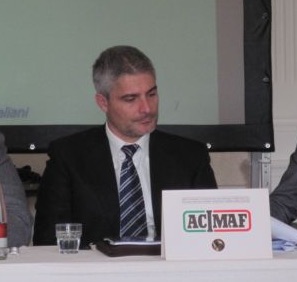
Pierluigi Viti, Sace Emilia manager
With analogue prerogatives mirroring the ones of the German private Consortium Euler Hermes, whose balance is connected with the State income statement, Sace is a 100% joint stock company controlled by “Cassa depositi e prestiti” and it is, together with a variety of ministries, committees and operational bodies, responsible in Italy for the promotion of our business abroad. Represented at Acimaf by the Emilia manager Emilia Pierluigi Viti, Sace illustrated some of the available instruments for supporting SME internationalization. Among them, commercial information services, sector studies and consulting, to export safely, identifying the markets with the highest potential according to the activity type and identifying opportunities and risks, evaluating also the reliability and soundness of eventual counterparts. Besides the data about the scenarios beyond the borders, Sace relies on a data bank containing 6 million names of partners, based on official and unofficial sources; besides, it offers recovery actions of judicial and extra-judicial credits. The company is in fact specialized in the insurance of credit and of non-payment risks, thanks to the preventive analysis of the creditworthiness of customers and potential ones and to the possibility of granting adequate coverages from the point of view of the political and commercial risk. It supports customers in the search of the best possible financial structure, providing the faculty of replacing in the credit portfolio a corporate risk with a Sace risk and of discounting trade receivables by the bank system. Among the financial warranties on funding or preparatory and instrumental activities for the growth abroad, in favour of SME or on funding for specific investments in favour of big companies, Sace assures the access to long-term funds and at favourable conditions. It supports then the increment of credit lines by the bank system and it allows benefitting from the zero weighting for the line percentage it grants. Several are then the forms of contractual warranties, in terms of guarantees and deposits, with the advantage of an overall improvement of the financial management and of the preservation of the available capacity in the banking system.
Finally, Sace manages the insurance coverage of the value of equity and loan investments against the loss or the failed repatriation of profits and invested capital in case of events of political nature like for instance wars and civil disorders; expropriations, breaches of contracts and currency restrictions.
850 events for 55,000 Italian companies
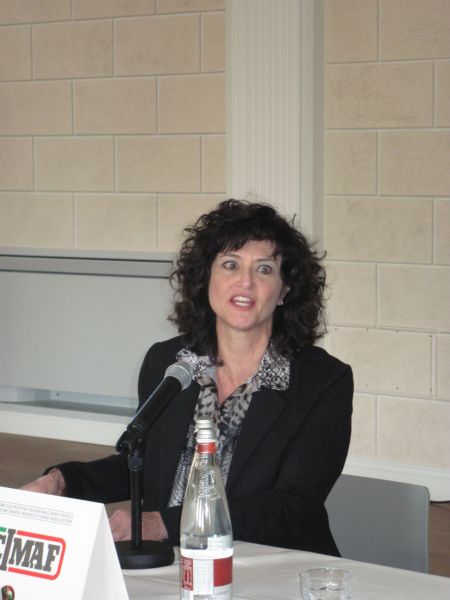
Caterina Marchionne, manager of the Mechanics office of Ice
Ice, in Parma with the Mechanical Office Manager Caterina Marchionne, operates as Agency for the promotion abroad and the internationalization of Italian enterprises, one of the operational Bodies dedicated to the support of the tricolour business outside domestic borders. Relying on a data bank from 55,000 enterprises and on the participation in 850 events of 70 sectors in 60 markets in the only 2015, over the last few years the agency has worked hard for the growth of wire machines. Targeted collective missions have concerned the sector on the occasion of international exhibitions in Countries like Brazil, India, China and United States. More in general, however, reminding that a strong interest is aroused by rising nations of Sub-Saharan Africa like Angola and Mozambique, Marchionne underlined that the focus of ICE activities are information, education, consulting and assistance services, including real promotion, in international scenarios. Its powerful database allows Ice to grant targeted proposals about single realities’ requirements, including surveys about the success potentialities of specific products and meetings, also at its offices, with possible foreign partners. At disposal, also thanks to financial support forms, also temporary export manager figures, support personnel aiding in the definition of the most suitable strategies for approaching foreign Countries successfully. Besides, in that scenario engineering plays a relevant role, with the 20-25% weight on overall resources.



